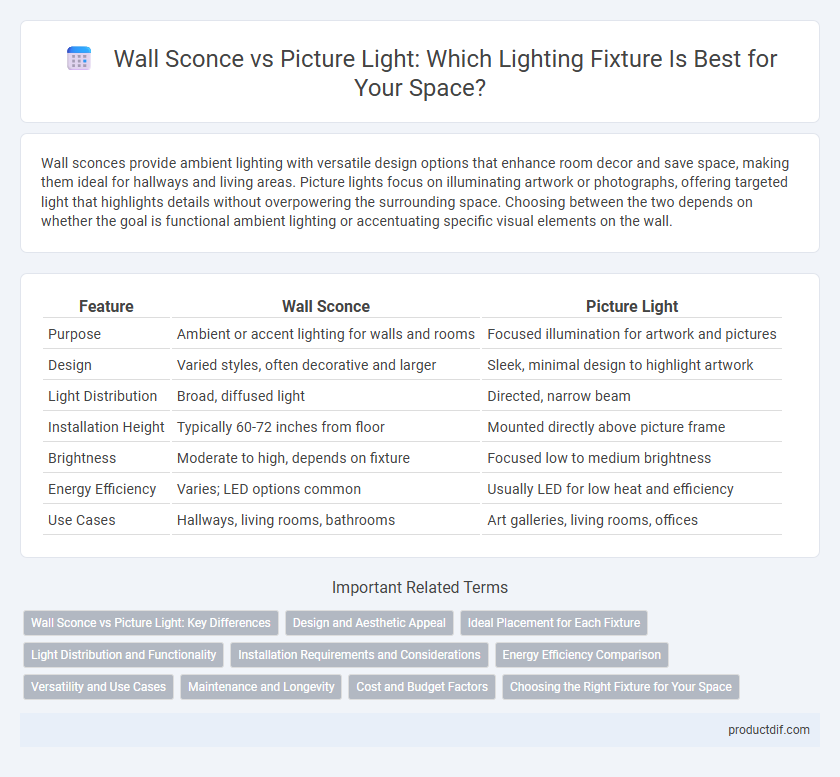Wall sconces provide ambient lighting with versatile design options that enhance room decor and save space, making them ideal for hallways and living areas. Picture lights focus on illuminating artwork or photographs, offering targeted light that highlights details without overpowering the surrounding space. Choosing between the two depends on whether the goal is functional ambient lighting or accentuating specific visual elements on the wall.
Table of Comparison
| Feature | Wall Sconce | Picture Light |
|---|---|---|
| Purpose | Ambient or accent lighting for walls and rooms | Focused illumination for artwork and pictures |
| Design | Varied styles, often decorative and larger | Sleek, minimal design to highlight artwork |
| Light Distribution | Broad, diffused light | Directed, narrow beam |
| Installation Height | Typically 60-72 inches from floor | Mounted directly above picture frame |
| Brightness | Moderate to high, depends on fixture | Focused low to medium brightness |
| Energy Efficiency | Varies; LED options common | Usually LED for low heat and efficiency |
| Use Cases | Hallways, living rooms, bathrooms | Art galleries, living rooms, offices |
Wall Sconce vs Picture Light: Key Differences
Wall sconces provide ambient or accent lighting by being mounted directly on the wall, often featuring decorative designs that enhance room aesthetics. Picture lights are specifically designed to illuminate artwork or photographs, delivering focused, directional light that highlights visual details without causing glare. The key difference lies in their purpose and light distribution: wall sconces contribute to overall ambiance, while picture lights serve as targeted illumination for art display.
Design and Aesthetic Appeal
Wall sconces offer versatile designs that enhance ambient lighting and complement interior decor with a range of styles from modern to traditional. Picture lights focus on highlighting artwork with sleek, unobtrusive profiles that draw attention to framed pieces without overpowering room aesthetics. Both lighting fixtures serve distinct aesthetic purposes, with wall sconces adding warmth and depth, while picture lights provide focused illumination to accentuate visual art.
Ideal Placement for Each Fixture
Wall sconces are ideally placed on either side of mirrors, doorways, or hallways to provide ambient and accent lighting, enhancing spatial balance and mood. Picture lights are best installed directly above artwork or photographs, concentrating light to highlight visual details without causing glare or damage to the frame. Proper placement ensures optimal functionality, aesthetic appeal, and preservation of the illuminated object or space.
Light Distribution and Functionality
Wall sconces provide broad, ambient light that enhances room atmosphere and highlights architectural features, while picture lights deliver focused, directional illumination specifically designed to accentuate artwork or photographs. The light distribution from wall sconces typically covers a larger area with soft, diffused glow, whereas picture lights concentrate beams directly on the framed piece to minimize glare and shadows. Functionality-wise, wall sconces serve both decorative and general lighting purposes, in contrast to picture lights which are specialized fixtures intended solely for art highlighting.
Installation Requirements and Considerations
Wall sconces require sturdy wall support and electrical wiring within the wall cavity, often needing professional installation to ensure safe and compliant connections. Picture lights are typically mounted above artwork using brackets and may require less electrical work, often powered by low-voltage or battery options, simplifying installation. Consider wall material, electrical access, and desired lighting effect when selecting between these fixtures to ensure optimal placement and functionality.
Energy Efficiency Comparison
Wall sconces typically use LED bulbs that consume around 8-12 watts, providing ample ambient lighting with low energy use, while picture lights often require smaller, focused fittings drawing 4-7 watts for highlighting artwork. Both lighting fixtures can be equipped with energy-efficient LED technology, but wall sconces generally cover wider areas with fewer units, reducing overall power consumption. Selecting dimmable or sensor-compatible models enhances energy savings by adjusting light output according to room needs.
Versatility and Use Cases
Wall sconces offer versatile lighting options suitable for ambient, task, and accent lighting in hallways, living rooms, and bedrooms, blending functionality with decorative appeal. Picture lights are specifically designed to highlight artwork or photographs, providing focused illumination that enhances visual detail without overpowering the surrounding space. Choosing between a wall sconce and a picture light depends on whether the goal is broad ambient lighting or targeted accentuation of wall art.
Maintenance and Longevity
Wall sconces typically require less frequent maintenance due to their robust design and sealed components, making them ideal for long-term use in various environments. Picture lights, while aesthetically focused, often need more careful upkeep to preserve their finish and ensure even illumination, which may impact their longevity. Choosing a wall sconce can result in lower maintenance costs and extended durability compared to picture lights in high-use or high-moisture areas.
Cost and Budget Factors
Wall sconces generally offer a wider price range, from $50 to $300, making them adaptable for various budgets, while picture lights typically cost between $70 and $250, with specialized models upwards of $400. Installation costs for wall sconces may be higher due to wiring complexity, whereas picture lights often involve simpler mounting and sometimes battery operation, reducing labor expenses. Budget decisions should consider both fixture price and installation fees, along with the desired ambiance and functional lighting needs.
Choosing the Right Fixture for Your Space
Wall sconces provide ambient or accent lighting and serve as decorative elements that enhance room ambiance, while picture lights are specifically designed to highlight artwork with focused illumination. Selecting the right fixture depends on the intended purpose: use a wall sconce for general or mood lighting along hallways or living areas, and opt for a picture light to accentuate paintings or photographs without glare. Consider the fixture's size, mounting height, and light temperature to ensure optimal functionality and aesthetic appeal in your space.
Wall Sconce vs Picture Light Infographic

 productdif.com
productdif.com